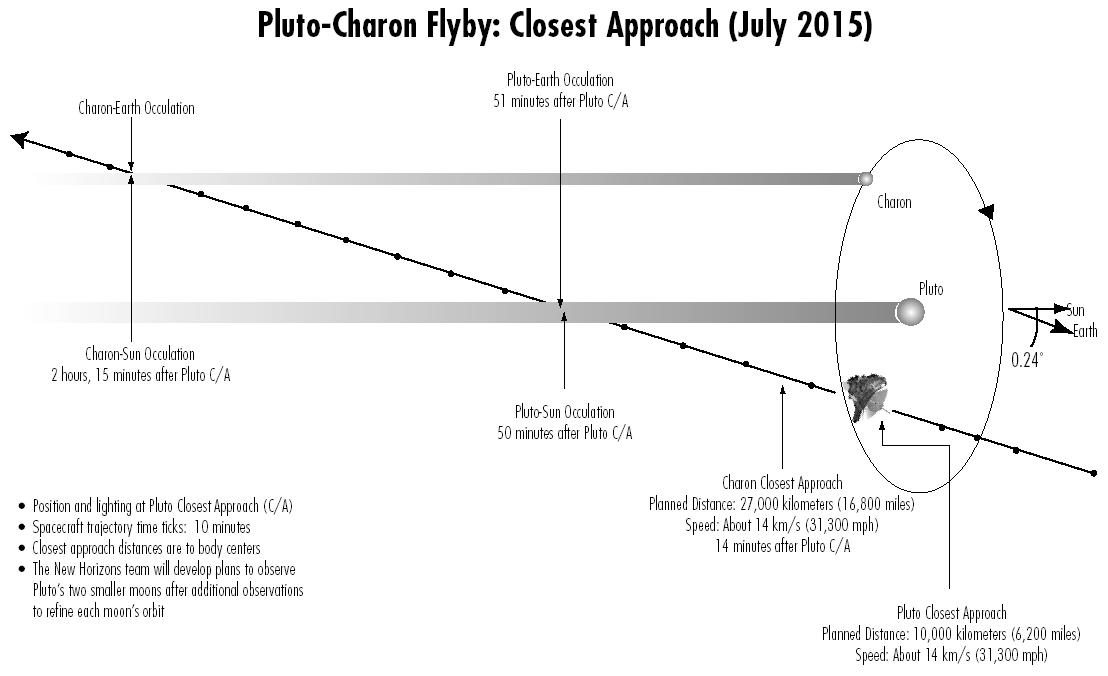Future Mission Goals
Even after
passing Jupiter, another seven years of travelling at more than 10 times faster
than a speeding bullet is necessary for New
Horizons to reach Pluto and the rest of the Kuiper belt, and it is expected
to arrive in July or August of 2015. But
even five months prior to the observations up close, New Horizons will start taking data. After the encounter, it will still make
observations for about four months. As
previously stated, this will be the first spacecraft to visit Pluto and its
moon, Charon. It should also be noted that New Horizons will be
the first mission to a binary object of any type, as Pluto and Charon form a
binary planet, whose gravitational balance point is between the two bodies due
to the fact that Charon is approximately one half the size of Pluto. Once
it closes in on the surface on the ice dwarf planet, it will take data for many
different goals. The sooner NASA
collects this data, the better, because Pluto has been moving further away from
the Sun, and its atmosphere may “freeze out” as it moves. We need to take data about the atmosphere
quickly before it gets any thinner.

There are many things that scientists would like to accomplish with this mission. The first is to map the surface temperature and the composition of Pluto and Charon. Pluto is a unique planet, one that is an ice dwarf in a binary planet system. By studying the surface temperature and composition of Pluto and Charon, we can gain insight as to how the planets in our solar system were formed. Another main point of the mission is to study the surface geology of Pluto and Charon. It is estimated that the photo maps of the planetismals will be able to resolve images about one kilometer across, with the highest resolution images getting down to sixty meters across. This will be monumental, as our best current photo resolution from the Hubble Space Telescope is only about five hundred kilometers across. The New Horizons mission would also like to gain some information regarding the neutral atmosphere of Pluto, along with its escape rate. Right now, Pluto’s atmosphere is escaping into space, like a comet would. This has not been found in any other planetary object in our solar system. It is thought that the early atmosphere of the Earth escaped into space in a similar way. By studying Pluto’s atmosphere, we can also learn about the early atmosphere of Earth.

Current evidence seems to point to Charon
having little to no atmosphere. Another objective of New Horizons is to discover whether or not this assumption is true,
and if it is false, what the composition of Charon’s atmosphere is and how
thick or thin it may be. Pluto’s atmosphere will be mapped with various
ultraviolet wavelengths. To observe the
surface of Pluto, it will also make spectral maps to find the temperature and
distribution of materials, and use a specific wavelength to find methane
frost. Another goal of the New Horizons mission will be to study
the impact of craters on the surface of Pluto, Charon, and other items in the
Kuiper Belt. This mission will be the first time that impact craters and other
surface features of Kuiper Belt objects can be studied in any detail. Around
Pluto, the spacecraft will look for rings of dust or any other satellites. We have recently found two very small
satellites, 100 to 150 kilometers in diameter. These objects are being
characterized as moons of Pluto, although they are two or three times farther
away than Charon. There could easily be more undiscovered objects around Pluto,
something New Horizions hopes to
find. On the way to Pluto, another
member of the Kuiper belt will be targeted to be explored. These objects will can be identified while New Horizions is approaching Pluto, and
studied following the spacecraft’s encounter with it. By studying these
objects, we will be able to find out if Pluto and Charon are typical to other
objects located in the Kuiper belt. Studies of other objects in the Kuiper Belt
are expected to take place between 2016 and 2020.